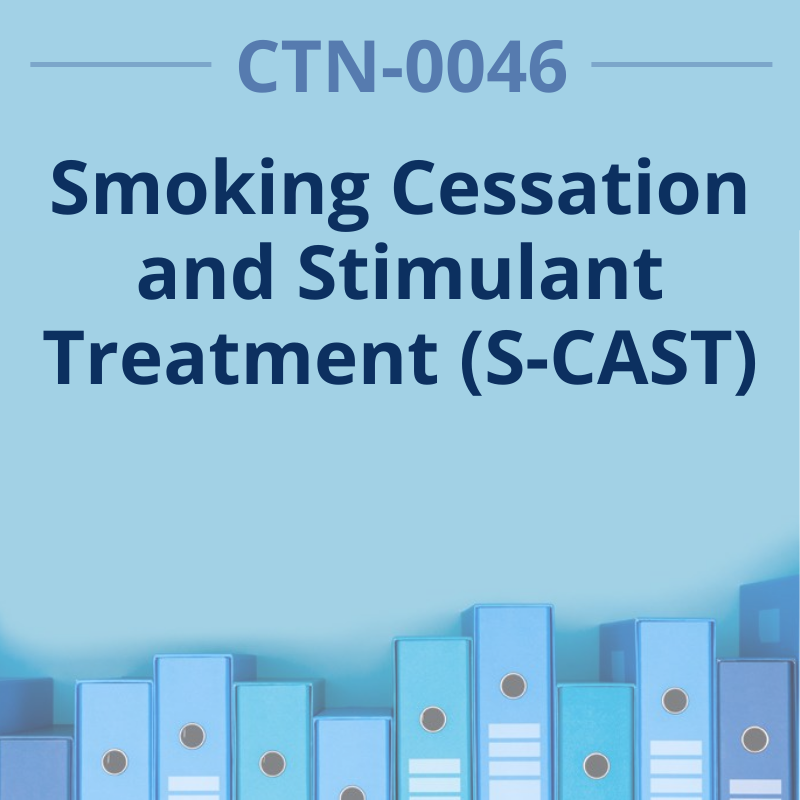CTN-0046: Smoking Cessation and Stimulant Treatment (S-CAST): Evaluation of the Impact of Concurrent Outpatient Smoking Cessation and Stimulant Treatment on Stimulant Dependence

T. John Winhusen, PhD
Lead Investigator
University of Cincinnati
Addiction Sciences Division
winhust@ucmail.uc.edu
The primary objective of this study is to evaluate the impact of substance abuse treatment as usual plus smoking cessation treatment (TAU+SCT), relative to substance abuse treatment as usual (TAU), on drug abuse outcomes. This is a 10-week, intent-to-treat, 2-group randomized controlled trial with follow-up visits at 3 and 6 months post-smoking quit date. Eligible participants will be randomized to the TAU+SCT or TAU arm. Participants randomized to the TAU+SCT arm will have a target quit smoking day at the end of study week 3. Participants randomized to the TAU+SCT arm will receive individual smoking-cessation counseling consisting of approximately one ten-minute counseling session per week during study weeks 1 through 10. In addition, all TAU+SCT participants will receive extended-release (XL) bupropion (300 mg/day) and, during the post-quit treatment phase, nicotine inhaler (6-16 cartridges per day ad libitum). Finally, all TAU+SCT participants will receive contingency management in which drawings for prizes are given for smoking abstinence as assessed by carbon monoxide (CO) levels during the post-quit phase of the trial (i.e., weeks 4-10). The study will evaluate whether concurrent smoking cessation treatment improves, worsens, or has no effect on drug abuse outcomes in smokers who are in outpatient substance abuse treatment for cocaine or methamphetamine dependence. Secondary objectives include evaluating: 1) the efficacy of TAU+SCT, relative to TAU, in improving smoking outcomes; 2) the safety of TAU+SCT relative to TAU.
Primary Findings
There were no significant treatment effects on stimulant-use outcomes, as measured by the primary outcome and stimulant-free days, on drug-abstinence, or on attendance.There was a similar lack of significant treatment effect on stimulant abstinence at 3-month and 6-month follow-ups. Participants receiving TAU with smoking cessation treatment, relative to those receiving TAU alone, however, had significantly better outcomes on smoking point-prevalence abstinence. Additionally, participants receiving TAU with smoking cessation treatment, relative to those receiving TAU alone, had significantly better outcomes for drug-free days (abstinence from all illicit substances, not just stimulants) at 6-month follow-up. These results suggest that providing smoking cessation treatment to illicit stimulant-dependent patients in outpatient substance use disorder treatment will not worsen, and may enhance, abstinence from non-nicotine substance use.

Primary Outcomes Article: Winhusen TM, et al. A randomized trial of concurrent smoking-cessation and substance use disorder treatment in stimulant-dependent smokers. Journal of Clinical Psychiatry 2014;75(4):336-343.
Related Studies
Related Resources
- CTN-0046 Study Protocol
- Publications in the Library about CTN-0046
- Study Data from NIDA Data Share
- ClinicalTrials.gov (NCT01077024)
- NIDA protocol page
Node Involvement
Lead Node(s):
All Participating Nodes: